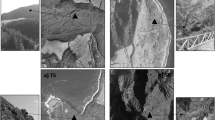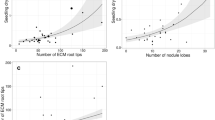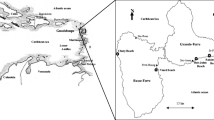Abstract
The bog sedge Kobresia myosuroides is among the first ectomycorrhizal (EM) plants forming dense pads on receding glacier forefronts of the Austrian Alps. This is the only Cyperaceae species known to form EM. To date, little is known about fungal species involved in these EM associations. Therefore, the main aim of this study was to detect EM fungal communities of K. myosuroides (1) by describing mycorrhizal morphotypes (MT) and (2) by identifying the mycobionts by rDNA internal transcribed spacer (ITS) sequencing. Furthermore, seasonal dynamics of Kobresia mycobionts were investigated. Sampling was performed in all four seasons (also under snow cover) during the years 2005 and 2006 at the Rotmoos glacier forefront, a well-characterized alpine primary successional habitat in the Austrian alps (2,300 m above sea level). The degree of EM infection of K. myosuroides roots was high (95%). Ten MTs were described and sequences of 18 fungal taxa were obtained. This was the highest mycobiont diversity ever reported for this plant. Cenococcum geophilum was the most abundant mycobiont (37–46%) and shared dominancy with Sebacina incrustans (16–44%) and Tomentella spp. (7–37%). Tomentella (including Thelephora) was the most species-rich mycobiont genus with five taxa, followed by Cortinarius, Inocybe, and Sebacina with two taxa each and one Hebeloma species. Other ascomycete mycobionts beside C. geophilum were Helvella sp., Lecythophora sp., and one Pezizales species. Due to high interannual differences in the EM fungal community, no significant seasonal changes could be detected. The importance of fungal mycobionts in alpine habitats is discussed.

Similar content being viewed by others
References
Agerer R (1991) Characterization of ectomycorrhiza. In: Norris JR, Read DJ, Varma AK (eds) Methods in microbiology. Academic, London, pp 27–73
Ammarellou A, Saremi H (2007) Mycorrhiza between Kobresia bellardii (All.) Degel and Terfezia boudieri Chatin. Turk J Bot 31:1–7
Blaschke H (1991) Distribution, mycorrhizal infection, and structure of roots of calcicole floral elements at tree line, Bavarian Alps, Germany. Arct Antarct Alp Res 23(4):444–450
Cázares E, Trappe JM, Jumpponen A (2005) Mycorrhiza-plant colonization patterns on a subalpine glacier forefront as a model system of primary succession. Mycorrhiza 15(6):405–416, doi:10.1007/s00572-004-0342-1
Colwell RK (2006) Estimates, version 8.0: Statistical estimation of species richness and shared species from samples (software and user’s guide)
Erschbamer B, Bitterlich W, Raffl C (1999) Die Vegetation als Indikator für die Bodenbildung im Gletschervorfeld des Rotmoosferners (Obergurgl, Ötztal). Ber Nat wiss-Med Ver Innsbruck 86:107–122
Fontana A (1963) Micorrhize ectotrofiche in una Ciperaceae: Kobresia belliardii Degl. Bot Ital 70:639–641
Gardes M, Bruns T (1993) ITS primers with enhanced specificity for basidiomycetes: application to the identification of mycorrhizae and rusts. Mol Ecol 2:113–118, doi:10.1111/j.1365-294X.1993.tb00005.x
Gardes M, Dahlberg A (1996) Mycorrhizal diversity in arctic and alpine tundra: an open question. New Phytol 133:147–157, doi:10.1111/j.1469-8137.1996.tb04350.x
Harrington TJ, Mitchell DT (2002) Colonization of root systems of Carex flacca and C. pilulifera by Cortinarius (Dermocybe) cinnamomeus. Mycol Res 106(4):452–459, doi:10.1017/S0953756202005713
Harrington TJ, Mitchell DT (2005) Ectomycorrhizas associated with a relict population of Dryas octopetala in the Burren, western Ireland. I. Distribution of ectomycorrhizas in relation to vegetation and soil characteristics. Mycorrhiza 15:425–433, doi:10.1007/s00572-005-0347-4
Haselwandter K, Read DJ (1980) Fungal associations of roots of dominant and sub-dominant plants in high-alpine vegetation systems with special reference to mycorrhiza. Oecologia 45(1):57–62, doi:10.1007/BF00346707
Kohn LM, Stasovski E (1990) The mycorrhizal status of plants at Alexandra Fiord, Ellesmere Island, Canada, a high arctic site. Mycologia 82(1):23–35, doi:10.2307/3759959
Kõljalg U, Larsson KH, Abarenkov K, Nilsson RH, Alexander IJ, Eberhardt U et al (2005) Unite: a database providing web-based methods for the molecular identification of ectomycorrhizal fungi. New Phytol 166(3):1063–1068, doi:10.1111/j.1469-8137.2005.01376.x
Krpata D, Mühlmann O, Kuhnert R, Ladurner H, Göbl F, Peintner U (2007) High diversity of ectomycorrhizal fungi associated with Arctostaphylos uva-ursi in subalpine and alpine zones: potential inoculum for afforestation. For Ecol Manage 250(3):167–175, doi:10.1016/j.foreco.2007.05.012
Lipson DA, Schadt CW, Schmidt SK, Monson RK (1999) Ectomycorrhizal transfer of amino acid-nitrogen to the alpine sedge Kobresia myosuroides. New Phytol 142(1):163–167, doi:10.1046/j.1469-8137.1999.00375.x
Lipson DA, Schadt CW, Schmidt SK (2002) Changes in soil microbial community structure and function in an alpine dry meadow following spring snow melt. Microb Ecol 43(3):307–314, doi:10.1007/s00248-001-1057-x
Massicotte HB, Melville LH, Peterson RL, Luoma DL (1998) Anatomical aspects of field ectomycorrhizas on Polygonum viviparum (Polygonaceae) and Kobresia bellardii (Cyperaceae). Mycorrhiza 7:287–292, doi:10.1007/s005720050194
McCune B, Mefford MJ (1999) Pc-ord. Multivariate analysis of ecological data. Version 5.0. MjM Software, Gleneden Beach
McCune B, Grace JB (2002) Analysis of ecological communities. MjM Software, Gleneden Beach
Mühlmann O, Peintner U (2008) Mycobionts of Salix herbacea on a glacier forefront in the Austrian Alps. Mycorrhiza 18(4):171–180, doi:10.1007/s00572-008-0169-2
Mühlmann O, Bacher M, Peintner U (2008) Polygonum viviparum mycobionts on an alpine primary successional glacier forefront. Mycorrhiza 18(2):87–95, doi:10.1007/s00572-007-0156-z
Näsholm T, Persson J (2001) Plant acquisition of organic nitrogen in boreal forests. Physiol Plant 111(4):419–426, doi:10.1034/j.1399-3054.2001.1110401.x
O’Donnell K (1993) Fusarium in near relatives. In: Reynolds D, Taylor J (eds) The fungal holomorph: mitotic, meiotic and pleomorphic speciation in fungal systematics. CBA International, Washington, DC, pp 225–233
Parrent JL, Vilgalys R (2007) Biomass and compositional responses of ectomycorrhizal fungal hyphae to elevated CO2 and nitrogen fertilization. New Phytol 176(1):164–174, doi:10.1111/j.1469-8137.2007.02155.x
Peintner U, Bougher NL, Castellano MA, Moncalvo JM, Moser MM, Trappe JM et al (2001) Multiple origins of sequestrate fungi related to Cortinarius (Cortinariaceae). Am J Bot 88(12):2168–2179, doi:10.2307/3558378
Raffl C, Erschbamer B (2004) Comparative vegetation analyses of two transects crossing a characteristic glacier valley in the Central Alps. Phytocoenologia 34(2):225–240, doi:10.1127/0340-269X/2004/0034-0225
Raffl C, Mallaun M, Mayer R, Erschbamer B (2006) Vegetation succession pattern and diversity changes in a glacier valley, Central Alps, Austria. Arct Antarct Alp Res 38(3):421–428, doi:10.1657/1523-0430(2006)38[421:VSPADC]2.0.CO;2
Schadt CW (2002) Studies on the fungal associations of the alpine sedge Kobresia myosuroides in Colorado. Ph.D. thesis, University of Colorado, Boulder, pp 110
Schadt CW, Martin AP, Lipson DA, Schmidt SK (2003) Seasonal dynamics of previously unknown fungal lineages in tundra soils. Science 301:1359–1361, doi:10.1126/science.1086940
Southworth D (2000) CTAB DNA extraction protocol. http://www.sou.edu/BIOLOGY/Faculty/Southworth/CTAB.htm
Tedersoo L, Suvi T, Larsson E, Kõljalg U (2006) Diversity and community structure of ectomycorrhizal fungi in a wooded meadow. Mycol Res 110:734–748, doi:10.1016/j.mycres.2006.04.007
Trowbridge J, Jumpponen A (2004) Fungal colonization of shrub willow roots at the forefront of a receding glacier. Mycorrhiza 14:283–293, doi:10.1007/s00572-003-0264-3
Vilgalys R (2005) Conserved primer sequences for PCR amplification and sequencing from nuclear ribosomal RNA. http://www.biology.duke.edu/fungi/mycolab/primers.htm#Internal%20transcribed%20spacer%20(ITS)%20region%20primers
Wang B, Qiu YL (2006) Phylogenetic distribution and evolution of mycorrhizas in land plants. Mycorrhiza 16(5):299–363, doi:10.1007/s00572-005-0033-6
White T, Bruns T, Lee S, Taylor J (1990) Amplification and direct sequencing of fungal ribosomal RNA genes for phylogenetics. In: Innis MA, Gelfand D, Sninsky J, White T (eds) PCR protocols: a guide to methods and applications. Academic, New York, pp 315–322
Acknowledgments
This study was financed by the FWF within the project “Seasonal dynamics of underground ectomycorrhizal fungal communities in an alpine primary successional habitat” project number P17910-B03. We thank M. Bacher, I. Oberkofler, R. Kuhnert, and V. Schmidt for their assistance with sampling.
Author information
Authors and Affiliations
Corresponding author
Electronic Supplementary Material
Below is the link to the electronic supplementary material.
Supplementary Fig. S1
Relative abundances (in percent) of K. myosuroides ectomycorrhizal main morphotypes (MT) identified as C. geophilum, S. incrustans, and Tomentella spp, all other MTs pooled, and senescent root tips are presented for each season (spring, summer, fall, winter) of both sampling years (2005 and 2006) separately (GIF 60 kb)
Supplementary Table S1
Mean temperature (T; °C) and moisture (relative values) 2 weeks before the samplings spring, summer, fall, and winter in 2005 and 2006. Values differing significantly between the years are marked with an asterisk (DOC 27 KB)
Supplementary Table S2
Main distinguishing features of K. myosuroides morphotypes (MT): descriptions of color, axis form, mantle surface, emanating elements, and mantle layer. Genera or species names for identified MTs are given (n.d.—not determined) (DOC 36 KB)
Supplementary Table S3
Abundances of K. myosuroides morphotypes (MT) at the Rotmoos glacier forefront in the sampling years 2005 and 2006. Samples are sorted in the following order: years, season, and plot (K1 to K5). MTs including senescent root tips (senescent) and nonmycorrhizal root tips (non-myc) are sorted in order of descending abundances in all samples pooled (DOC 117 KB)
Rights and permissions
About this article
Cite this article
Mühlmann, O., Peintner, U. Ectomycorrhiza of Kobresia myosuroides at a primary successional glacier forefront. Mycorrhiza 18, 355–362 (2008). https://doi.org/10.1007/s00572-008-0188-z
Received:
Accepted:
Published:
Issue Date:
DOI: https://doi.org/10.1007/s00572-008-0188-z




